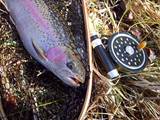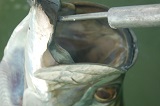I posted this question in the Rod Building section. Posting it here hoping more people see it...
Fellas... I just bought an inexpensive ECHO Base fly rod 9' 6wt as a backup surf casting rod. Of course, I didn't check to see if it had a fighting butt. And naturally, it doesn't. I'd like one on it. Do I really need a fighting butt? I have no idea. Do I really WANT a fighting butt? Yes I do - just in case I butt-hook something big like that corbina that dragged me around a few weeks back.
So my question is, is it possible to have the blank end-cap from this rod removed and add have a fighting butt installed in its place? If yes, does anyone know anyone that could do the work?
Many thanks, Creek
REALTIME FLOWS  U. Kern: n/a cfs
U. Kern: n/a cfs
 L. Kern: 1341 cfs
L. Kern: 1341 cfs
 E.W: 312 cfs
E.W: 312 cfs
 U. Owens: 108 cfs
U. Owens: 108 cfs  L. Owens: 496 cfs 09/02/19 1:15 PM PST
L. Owens: 496 cfs 09/02/19 1:15 PM PST
Fighting butt question..
12 posts
• Page 1 of 1
Fighting butt question..
"You can't keep a good Dr down."
Days On The Salt in 2017 - 114
Days On The Salt in 2018 - 39

Days On The Salt in 2017 - 114
Days On The Salt in 2018 - 39

-

DrCreek - Posts: 1417
- Joined: January 31st, 2008, 9:46 pm
- Location: CA
Re: Fighting butt question..
TFO has a 3 pack of fighting butts. They just fit over the end cap. Not too bad IMO. You will need a fighting butt sooner or later.
" Boy it's going to be really hard not to do this again tomorrow!!"
-

flyster - Posts: 848
- Joined: February 28th, 2010, 5:26 pm
- Location: Pomona,Ca.
Re: Fighting butt question..
Thanks Fly.. I ordered a set for giggles. maybe it will do the trick.
Mike
Mike
"You can't keep a good Dr down."
Days On The Salt in 2017 - 114
Days On The Salt in 2018 - 39

Days On The Salt in 2017 - 114
Days On The Salt in 2018 - 39

-

DrCreek - Posts: 1417
- Joined: January 31st, 2008, 9:46 pm
- Location: CA
Re: Fighting butt question..
The fighting butt definitely helps when leveraging bigger fish. I always though "whatever" but have a 6 & 8wt with them I wouldn't trade.
"We're a cross between our parents and hippies in a tent...."
180 Degrees South
180 Degrees South
-

WanderingBlues - Posts: 5299
- Joined: December 2nd, 2009, 10:49 am
- Location: Living in a Tin Can
Re: Fighting butt question..
I'd LOVE to be able to just pop off the blank cap and replace it with a fighting butt, but I'm sure they come in different sizes and shapes and I'd have no idea how to get it off safely, make the new one stick, etc.
"You can't keep a good Dr down."
Days On The Salt in 2017 - 114
Days On The Salt in 2018 - 39

Days On The Salt in 2017 - 114
Days On The Salt in 2018 - 39

-

DrCreek - Posts: 1417
- Joined: January 31st, 2008, 9:46 pm
- Location: CA
Re: Fighting butt question..
Grips, reel seats, end caps, and reel hardware are usually assembled with two part epoxy glue. Some epoxy glues go mushy with heat gun heat, but not all. I can't tell which ones do, but others may know.
During Rod building, it is easy to glue and shape a wooden dowel to fit into the hollow part of Rod blank and and turn cork or rubberized end cap into a fighting butt.
Since deconstructing is not exact, the work to rebuild may include a couple extra steps and extra parts to complete the job. An experienced Rod builder should be able to cover the steps. A suggestion or two of whom to contact may respond to your post.
Ants
During Rod building, it is easy to glue and shape a wooden dowel to fit into the hollow part of Rod blank and and turn cork or rubberized end cap into a fighting butt.
Since deconstructing is not exact, the work to rebuild may include a couple extra steps and extra parts to complete the job. An experienced Rod builder should be able to cover the steps. A suggestion or two of whom to contact may respond to your post.
Ants
- Ants
- Posts: 718
- Joined: May 2nd, 2013, 7:04 pm
Re: Fighting butt question..
DrCreek wrote:I'd LOVE to be able to just pop off the blank cap and replace it with a fighting butt, but I'm sure they come in different sizes and shapes and I'd have no idea how to get it off safely, make the new one stick, etc.
It can be done but it's more trouble than its worth.
-

clee - Posts: 747
- Joined: May 30th, 2011, 10:41 pm
Re: Fighting butt question..
clee wrote:DrCreek wrote:I'd LOVE to be able to just pop off the blank cap and replace it with a fighting butt, but I'm sure they come in different sizes and shapes and I'd have no idea how to get it off safely, make the new one stick, etc.
It can be done but it's more trouble than its worth.
That's what I had figured as well - from reading internet forums on the subject. Im not willing to trash a rod just to swap caps. I'll leave it alone and add that TFO EVA butt when it comes in the mail. Hope that fits the bill. Thanks, Clee !
"You can't keep a good Dr down."
Days On The Salt in 2017 - 114
Days On The Salt in 2018 - 39

Days On The Salt in 2017 - 114
Days On The Salt in 2018 - 39

-

DrCreek - Posts: 1417
- Joined: January 31st, 2008, 9:46 pm
- Location: CA
Re: Fighting butt question..
Mike
If you need help just give me a ring I would be glad to help and it is really easy as well.
Jon
If you need help just give me a ring I would be glad to help and it is really easy as well.
Jon

2013: Days on the Water so far - 29
2014: Days on the Water so far - 28
-

stanbery - Posts: 4410
- Joined: July 26th, 2008, 2:00 am
- Location: Palmdale CA
Re: Fighting butt question..
DrCreek wrote:Do I really need a fighting butt?
I prefer a fighting but on 8WT and up, or on long rods down to 6WT. I have several 9' 6WTs with fighting butts too, but I don't recall ever needing the butt. Probably reflects the way I fight fish. As for butt-hooked fish? I break them off the moment I see they're fouled, regardless of rod weight.
- BrownBear
- Posts: 758
- Joined: February 14th, 2014, 10:39 am
Re: Fighting butt question..
BrownBear wrote:DrCreek wrote:Do I really need a fighting butt?
I prefer a fighting but on 8WT and up, or on long rods down to 6WT. I have several 9' 6WTs with fighting butts too, but I don't recall ever needing the butt. Probably reflects the way I fight fish. As for butt-hooked fish? I break them off the moment I see they're fouled, regardless of rod weight.
I lke a fighting butt on all the fly rods I take to the beach and bay, even my 4wt (Jim Teeny model TFO - now discontinued). On the bigger corbina, halibut and SNGF it helps to anchor the butt of the rod in my tummy during the fight.
Life is good. Eternal life is better!
Richard
Richard
- RichardCullip
- Posts: 4052
- Joined: February 23rd, 2008, 10:55 pm
- Location: Poway, CA
Re: Fighting butt question..
I hear what you're saying Richard. But my problem with using fighting butts on lighter rods has to do with "transitions" from fighting with the butt in my gut up into an overhead rod position for more flex and response if I hook a bigger fish and it goes crazy. Seems counter-intuitive, but with hard pullers I want the butt up and free for more responsive rod movement when needed.
Here's but one example: I have three 10' 4-weight rods stretching back over the years- The first I got over 30 years ago is a Scott. Next up a few years later is a Sage. The last I got about 5 years back is a TFO BVK. Love the latter most, both for its light weight and 4-piece construction for travel. When I first got the Scott, then the Sage, I pined for a fighting butt and even considered serious surgery for a retro. Glad I didn't, as it turned out.
Back then we made annual 10-14 day trips down to Kodiak's famed king salmon river, the Ayakulik. Got there one year in a stretch of bright days and low water. The kings refused to play ball except in low light, which meant from about 10PM til 11PM or so, then again from 4AM til as late as 6AM on good days. That left a whoooooole lot of fishless hours in the day.
I'd brought along that 10' Sage 4WT because there are decent rainbows to 20-22" in the river when you know where to look for them along with Dolly Varden that ranged up to 26-28". After a few days of laying around and napping through midday, I remembered the 4WT and decided to get busy with the trout.
About my 3rd cast a king glommed onto the 1/4" Glo Bug I was tossing. Managed to land it and killed it to fill the fish-less hole in our menu. Weighed back at camp it was 28#. Heck of a workout for the rod and used up about a half mile of river tracking that fish. Tired arms led me to pull the butt down to my waist several times for a makeshift fighting butt shifting my rod hand back as far as possible, then resting the heel of my hand against my waist. But every time I did it, the king did something crazy and I had to get the rod back up over my head quickly. Hooked yet another king on that little fly the very next cast, but pointed the rod at it after the first run. Hooked two more on the same fly over the next couple of hours, and pointed the rod at them, too. Got over the impulse for a fighting butt on light rods overmatched for their quarry, when intuition might tell you a fighting butt would be good.
Another lesson learned that really saved the trip, and has been useful ever since:
The king bite wasn't "off" during those bright hours. They were simply off the big traditional king flies we had always tossed. As an experiment I went back to camp and tied tiny versions of the standards on larger hooks, along the lines of "low water" Atlantic salmon and steelhead flies. The big hooks added weight for dredging bottom while also giving a better hook-up for fighting big kings. Using those flies we caught kings all day long, when a switch back to the bigger versions put an immediate stop to fish catching. I do the same to this day for coho salmon in rivers and lakes.
Here's but one example: I have three 10' 4-weight rods stretching back over the years- The first I got over 30 years ago is a Scott. Next up a few years later is a Sage. The last I got about 5 years back is a TFO BVK. Love the latter most, both for its light weight and 4-piece construction for travel. When I first got the Scott, then the Sage, I pined for a fighting butt and even considered serious surgery for a retro. Glad I didn't, as it turned out.
Back then we made annual 10-14 day trips down to Kodiak's famed king salmon river, the Ayakulik. Got there one year in a stretch of bright days and low water. The kings refused to play ball except in low light, which meant from about 10PM til 11PM or so, then again from 4AM til as late as 6AM on good days. That left a whoooooole lot of fishless hours in the day.
I'd brought along that 10' Sage 4WT because there are decent rainbows to 20-22" in the river when you know where to look for them along with Dolly Varden that ranged up to 26-28". After a few days of laying around and napping through midday, I remembered the 4WT and decided to get busy with the trout.
About my 3rd cast a king glommed onto the 1/4" Glo Bug I was tossing. Managed to land it and killed it to fill the fish-less hole in our menu. Weighed back at camp it was 28#. Heck of a workout for the rod and used up about a half mile of river tracking that fish. Tired arms led me to pull the butt down to my waist several times for a makeshift fighting butt shifting my rod hand back as far as possible, then resting the heel of my hand against my waist. But every time I did it, the king did something crazy and I had to get the rod back up over my head quickly. Hooked yet another king on that little fly the very next cast, but pointed the rod at it after the first run. Hooked two more on the same fly over the next couple of hours, and pointed the rod at them, too. Got over the impulse for a fighting butt on light rods overmatched for their quarry, when intuition might tell you a fighting butt would be good.
Another lesson learned that really saved the trip, and has been useful ever since:
The king bite wasn't "off" during those bright hours. They were simply off the big traditional king flies we had always tossed. As an experiment I went back to camp and tied tiny versions of the standards on larger hooks, along the lines of "low water" Atlantic salmon and steelhead flies. The big hooks added weight for dredging bottom while also giving a better hook-up for fighting big kings. Using those flies we caught kings all day long, when a switch back to the bigger versions put an immediate stop to fish catching. I do the same to this day for coho salmon in rivers and lakes.
- BrownBear
- Posts: 758
- Joined: February 14th, 2014, 10:39 am

